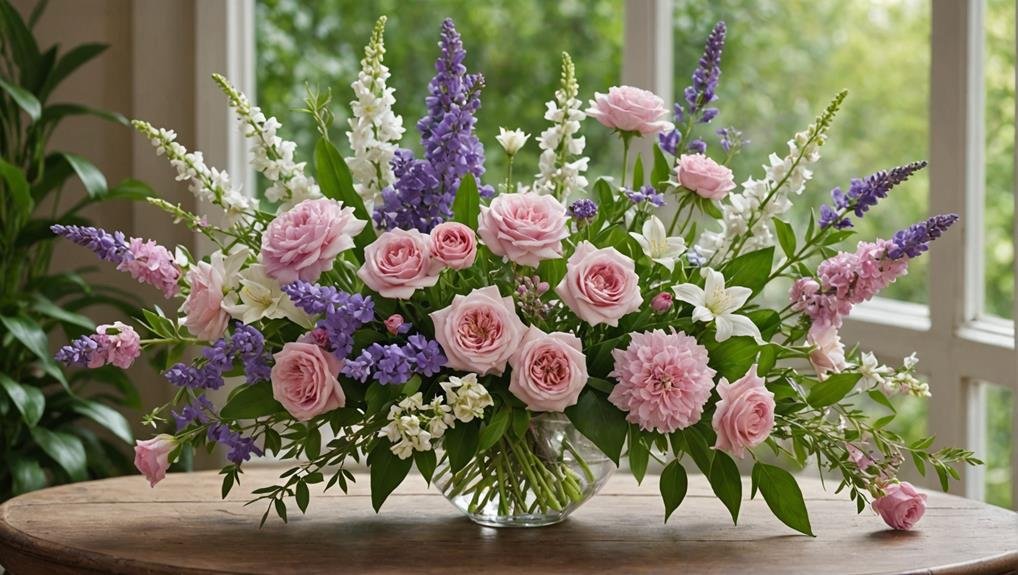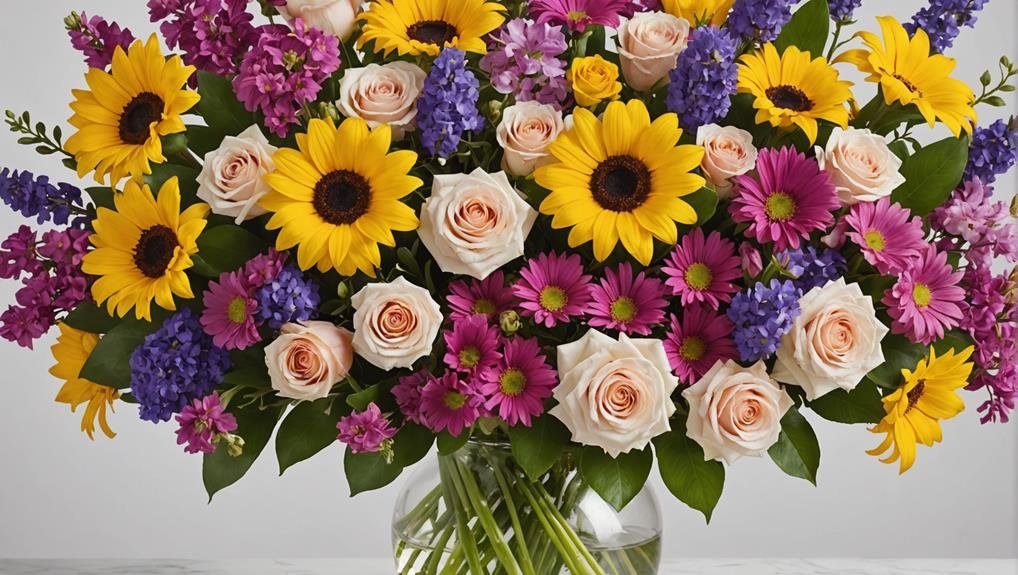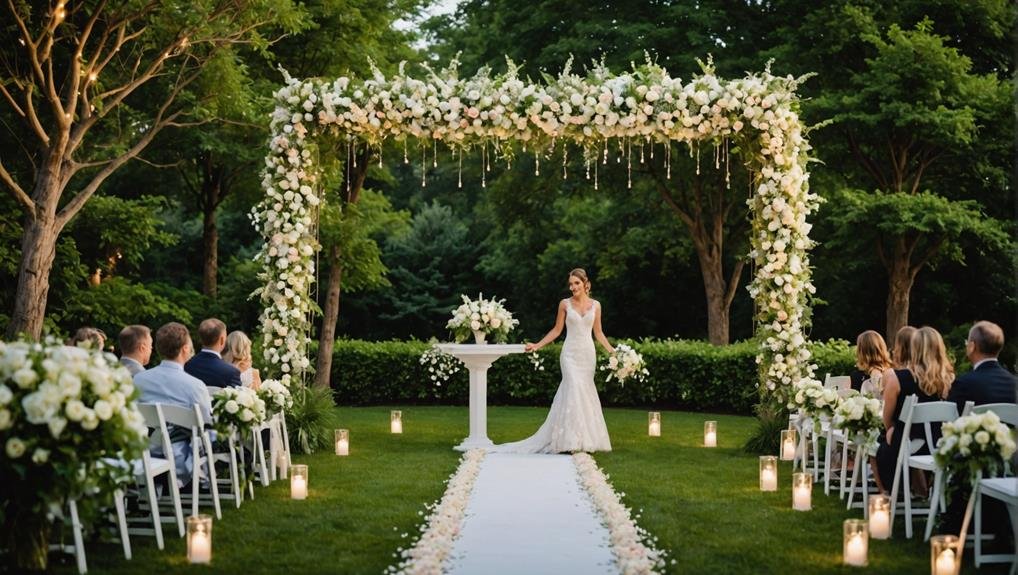When planning a wedding, the choice of flowers plays a vital role in setting both the aesthetic and emotional tone of the event. Among the wide range of floral options available, stock flowers, also known as gillyflowers, stand out for their ruffled petals and enchanting fragrance. Available in an array of colors such as white, peach, lavender, yellow, and purple, each hue carries its unique symbolism, from purity to joy. Their versatility makes them ideal for bridal bouquets, centerpieces, and DIY arrangements. With their rich history and symbolic meanings, stock flowers offer more than just beauty. But how do their origins and growing conditions contribute to their popularity in weddings?
Flower Overview

Stock flowers, also known as gillyflowers or Virginia stock, are sweetly scented blooms widely favored for wedding bouquets and arrangements. Their delightful fragrance and elegant appearance make them a popular choice for floral arrangements, particularly in the context of wedding flowers.
Named in honor of the Italian botanist Pietro Andrea Matthioli, these flowers are typically sold in wraps of 10 stems, reaching lengths of up to 60 centimeters.
When preparing stock flowers for use in wedding arrangements, it is important to follow specific conditioning steps to maintain their longevity and freshness. First, upon receiving wholesale stock flowers from a supplier or Web-Shop, the stems should be cut at a 45-degree angle. This technique enhances water absorption. Additionally, lower foliage should be removed to prevent bacterial growth in the water.
To condition the flowers, fill buckets with lukewarm water and add a suitable flower food, which provides essential nutrients and helps maintain the flowers' vibrant appearance. Allow the stock flowers to rest overnight in a cool, dark place away from direct sunlight.
This preparation process is essential for achieving the best results in your floral arrangements, ensuring that the wedding flowers remain fresh and fragrant throughout the event.
Physical Description
Matthiola, commonly known as stock flowers, feature tall, sturdy stems adorned with clusters of small, ruffled blooms. These blooms are renowned for their sweet fragrance and charming appearance, making them a popular choice for wedding bouquets and floral arrangements.
Stock flowers are typically sold in wraps of 10 stems, each reaching impressive lengths of up to 60 centimeters.
To ensure the longevity of these cut flowers, it is essential to cut the stems at a 45-degree angle and remove lower foliage. This practice helps the flowers absorb water more efficiently, enhancing their vase life.
Once the stems are prepared, it is recommended to condition the stock flowers overnight in lukewarm water mixed with flower food. This conditioning process fortifies the blooms, allowing them to fully open and display their ruffled petals.
For best freshness, store stock flowers in a cool place, away from direct sunlight and ethylene gas emitted by ripening fruit. This careful storage preserves the vibrant beauty of the blossoms, whether they are white stock or another variety.
Available Colour Varieties

Beyond their physical beauty and enchanting fragrance, stock flowers offer a diverse palette of color varieties, including white, peach, lavender, yellow, and purple. These options provide brides and wedding planners with a wide range of colors to suit any wedding palette and theme. The versatility of stock flowers in floral arrangements is unmatched, as each color carries its own unique symbolism and visual appeal.
The range of colors available makes stock flowers an ideal choice for creating cohesive and visually stunning floral designs. Here are four popular color varieties and their significance in wedding decor:
- White Stock: Symbolizes purity and elegance, perfect for traditional and minimalist wedding themes.
- Peach Stock: Represents warmth and romance, ideal for rustic and vintage-inspired weddings.
- Lavender Stock: Evokes a sense of calm and serenity, suitable for bohemian and garden-themed weddings.
- Yellow Stock: Signifies joy and happiness, great for cheerful and vibrant wedding celebrations.
Latin Name and Taxonomy
The scientific categorization of stock flowers places them in the Matthiola genus of the Brassicaceae family, with Matthiola incana being the most commonly cultivated species. The genus Matthiola was named in honor of Pietro Andrea Matthioli, a distinguished 16th-century Italian botanist and physician known for his contributions to plant taxonomy and medicinal botany.
Within the Brassicaceae family, stock flowers are closely related to other members, such as cabbages and mustards, which share similar structural characteristics.
The scientific name Matthiola incana reflects both the genus and species, indicating its unique place within botanical classification. Matthiola incana is particularly valued for its sweet fragrance, which makes it a popular choice for bridal bouquets and other floral arrangements. The plant's robust stems can reach lengths up to 60cm, providing an elegant and substantial presence in various decorative contexts.
In addition to its aesthetic appeal, the categorization of Matthiola incana is vital for understanding its horticultural requirements and breeding potential. Accurate identification by its scientific name ensures proper care and handling, especially when bought wholesale, where conditioning and preparation techniques are necessary for maintaining its freshness and vibrancy.
Geographical Origins

Originating from the sunny Mediterranean region, stock flowers have adapted to thrive in warm climates with well-drained soil and abundant sunlight. Known scientifically as Matthiola, these flowers bear the name of Pietro Andrea Matthioli, an esteemed Italian botanist and physician.
The geographical origins of stock flowers significantly influence their growth preferences, making them well-suited for environments that replicate the Mediterranean's characteristic conditions. Stock flowers have been cultivated for centuries, showcasing their resilience and adaptability. This long history of cultivation has allowed them to become a staple in the floral industry, celebrated for their sweet scent and vibrant hues.
Here are some key points about their geographical origins:
- Mediterranean Region: Stock flowers naturally occur in this area, which provides the ideal climate for their growth.
- Warm Climates: They flourish in regions with mild winters and warm summers, similar to their native habitat.
- Well-Drained Soil: These flowers prefer soil that allows water to flow through easily, preventing root rot and other moisture-related issues.
- Ample Sunlight: Exposure to plenty of sunlight is essential for their development, enhancing their vibrant blooms and overall health.
Understanding the geographical origins of stock flowers highlights their suitability for various applications, particularly in wedding decor where their beauty and fragrance can be fully appreciated.
Season Availability
Seasonal availability plays a significant role in planning wedding floral arrangements, guaranteeing that stock flowers can be sourced year-round for various events. Stock flowers, known for their delicate and elegant appearance, are available throughout the year, providing reliability and flexibility for wedding planners and florists. This year-round availability is crucial, particularly for events that require specific colors and styles, irrespective of the season.
However, the seasonality of stock flowers can still impact their condition and pricing. Extreme weather conditions may affect their freshness and overall quality, making proper hydration essential. When purchasing in bulk, it is vital to take into account both availability and seasonality to make sure that the flowers meet expectations without compromising affordability.
| Season | Availability | Condition |
|---|---|---|
| Spring | High | Optimum |
| Summer | Moderate | Requires proper hydration |
| Winter | Low | More attention needed |
Flower Moxie offers convenient online ordering options, guaranteeing timely delivery for DIY weddings and events. Their services are tailored to meet the diverse needs of clients, making bulk purchases more accessible and effective. Understanding the seasonality and care requirements of stock flowers helps in preserving their flawless condition, ensuring a stunning and memorable wedding floral arrangement.
Growing Conditions

Understanding the best growing conditions for stock flowers is essential for achieving their full blooming potential and maintaining their health. Stock flowers thrive in environments that provide full sun to partial shade, which guarantees they receive adequate light for robust growth. Optimal growth is achieved in well-draining soil, preventing the detrimental effects of waterlogging.
Stock flowers prefer cool temperatures ranging between 50-70°F. They can withstand light frost, making them versatile for various climates. Regular watering is essential; maintaining consistently moist soil without over-saturating helps to keep the plants healthy and vibrant.
Good air circulation is another important factor, as it helps to prevent diseases that can be harmful to stock plants. This makes them suitable for both outdoor and greenhouse cultivation. The tall stems of stock flowers produce clusters of fragrant flowers, which are a desirable feature for many gardeners and florists.
Here are the key growing conditions for stock flowers:
- Direct sunlight: Guarantee full sun to partial shade.
- Cool temperatures: Maintain a range of 50-70°F.
- Regular watering: Keep soil consistently moist but not waterlogged.
- Good air circulation: Promote airflow to prevent disease.
Cultural Significance
Stock flowers, revered for their cultural symbolism, embody ideals of happiness, purity, and enduring beauty. Originating from the Mediterranean regions, these blossoms, also known as gillyflowers, have long been associated with positive emotions and are often employed in weddings and special occasions to convey these sentiments. The rich cultural symbolism of stock flowers makes them a cherished choice in various traditions, where they are valued for their symbolic meanings.
Different colors of stock flowers add layers of meaning to floral arrangements. For instance, white stock flowers symbolize purity and innocence, making them a fitting addition to wedding decor. Peach and yellow stock flowers represent happiness and contentment, while lavender and purple hues are associated with admiration and lasting beauty. These varied symbolic meanings make stock flowers a versatile option for creating meaningful and aesthetically pleasing floral arrangements.
The sweet scent and vibrant colors of stock flowers further enhance their appeal, often used in bouquets, centerpieces, and other floral decor. Their cultural significance and aesthetic charm guarantee that stock flowers remain a popular and meaningful addition to weddings and other special occasions, enriching the atmosphere with their beauty and symbolism.
Typical Use in Weddings

The cultural significance and aesthetic appeal of stock flowers naturally extend to their typical use in weddings, where they are valued for their sweet scent, fluffy blooms, and versatile colors. Stock flowers are a popular choice for both their beauty and practicality, making them ideal for various wedding floral arrangements.
- Bouquets: Stock flowers are often used in bridal bouquets, where their sweet scent and vibrant colors can stand out or blend harmoniously with other blooms. Their sturdy stems and lush blossoms contribute to a full, elegant look.
- Centerpieces: As centerpieces, stock flowers add height and texture to table arrangements. Their versatile colors allow them to complement a wide range of wedding themes and palettes, from classic white to vibrant, joyful hues.
- Filler Flowers: Stock flowers are frequently employed as filler flowers to add volume and texture to larger floral compositions. They pair well with roses, peonies, and greenery, creating a rich, multi-dimensional appearance.
- DIY Arrangements: For DIY brides, stock flowers are particularly appealing due to their easy handling and long vase life. This makes them a cost-effective choice for creating stunning, long-lasting arrangements without professional assistance.
Incorporating stock flowers into wedding decor guarantees a fresh, romantic ambiance that delights the senses.
Alternative Flower Types
Exploring alternative flower types such as snapdragons, Queen Anne's Lace, and lisianthus can enhance the diversity and visual appeal of wedding floral arrangements. These unique options bring a rich tapestry of colors, shapes, and textures that complement traditional stock flowers beautifully.
Adding filler flowers like baby's breath, wax flowers, or asters can further elevate the design by providing additional texture and volume, creating a fuller and more dynamic display.
Incorporating unique options such as delphiniums, veronicas, or scabiosa can introduce an element of surprise and interest, ensuring that each arrangement stands out. The inclusion of greenery, such as eucalyptus, ferns, or ivy, contributes to a natural and organic aesthetic, seamlessly blending with the floral elements while adding depth and movement to the overall composition.
For those looking to add a touch of sophistication and elegance, exotic blooms like proteas, orchids, or anthuriums are excellent choices. These striking flowers can serve as focal points within the arrangement, drawing attention and admiration.
